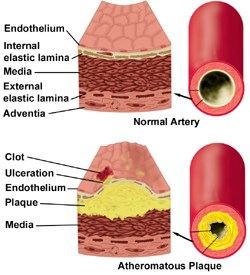Arteries

Arteries are blood vessels that carry blood from the heart to the organs, supplying them with nutrients and oxygen. It is made up of three layers, tunica intima, tunica media and tunica adventitia. Tunica intima is the inner most layer of the arteries and it is line by endothelium. The health of the endothelium is crucial to the health of the artery. Many chronic conditions such as diabetes, high blood pressure and renal failure and our lifetsyle habits contribute to damage of the health of the endothelium, resulting in its injury and formation of atheromatous plaque. Artheromatous plaque result from subendothelial accumulation of fatty substances. This is a process that develops over many years and eventually result in narrowing or blockage of the arteries. The fatty deposit of the artheromatous plaque is friable and can break off and travel within the circulation to cause stroke, blue toe syndrome, kidney damage or heart attack. Statin is able to help reduce the damage to the endothelium by improving the lipid profile. In addition it also reduce the friability of the plaque by reducing the enzymes that cause the plaque to be unstable (matrix metalloproteinases or MMP) and enhance the formation of a smooth lining over the plaque to prevent it from becoming loose.
Veins
Veins are blood vessels that carry waste products and carbon dioxide from the organs to the heart and subsequently get exchanged for fresh oxygen in the lung. They are similar to artery in that they have three layers in the wall and are called tunica intima (lined by endothelium), tunica media and tunica adventitia. The middle layer, tunica media is made up of smooth muscle, however it is much thinner in comparison to the artery, and therefore veins are not contractile. Blood is carried in the vein in one direction and that is towards the heart. There are valves inside the vein that ensure that blood travels towards the heart. Blood is pumped inside the vein towards the heart by the muscles of the limbs and also by the negative pressure created by the diaphragm within the chest.
Veins in the legs are the veins that is most frequently affected by vascular conditions such as varicose veins and deep vein thrombosis. The veins of the legs can be divided into those that are superficial (usually visible from the surface) and the deep vein located within the muscles of the legs. Varicose veins is a result of failure of the valves within the vein to perform its function, resulting in reflux of the blood column. Deep vein thrombosis is the formation of clot inside the deep veins of the leg. The clot sets up an inflammatory reaction within the vein and eventually leads to destruction of the valve resulting in chronic venous insufficiency.

